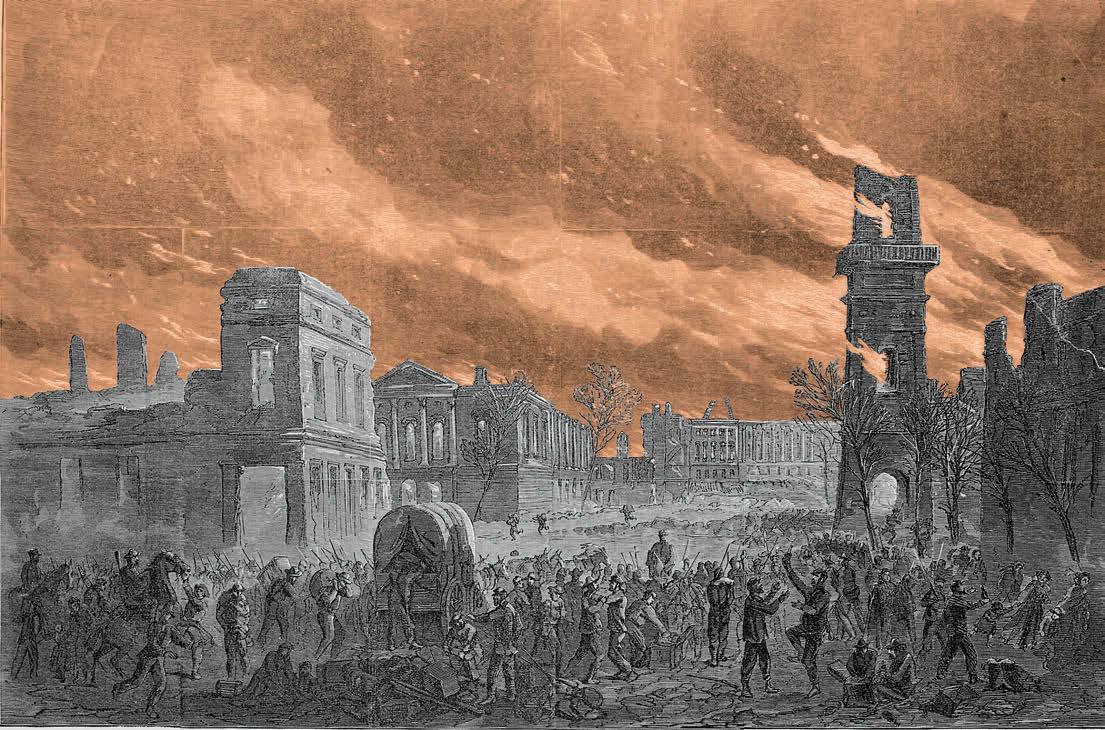
He believed that Southerners’ willingness to fight had to be destroyed. The best way to do that, he thought, was to engage in “total war”—to make citizens feel the pain of war and hate it as much as he did. He believed that if Southern citizens experienced the horrors of war—and had to survive in the destruction left behind by an invading army that killed their horses and mules, tore up their railroads, and burned their factories—their support for the war and the Confederacy would fade quickly.
Sherman had applied this philosophy in his campaign through Georgia in the fall of 1864. In his famous March to the Sea, he cut his supply lines and told his army to live off the land. It was an effective and devastating military tactic. In places along Sherman’s route, citizens were left without food or shelter. Upon reaching the Atlantic coast and seizing Savannah in late December, Sherman spent the month of January 1865 preparing for his next move.
Pontoon bridges are temporary floating bridges that use a series of flatbottomed boats for support.
At first, Lieutenant General Ulysses S. Grant planned to have the Union Navy transport Sherman’s army to join Grant and the Army of the Potomac in Virginia so that together they could defeat Confederate general Robert E. Lee. But Sherman proposed that he march his army through the Carolinas to Virginia. When not enough boats were available for his original plan, Grant approved Sherman’s suggestion.
Diese Geschichte stammt aus der January 2025: 1865: A Year in the Civil War-Ausgabe von Cobblestone American History Magazine for Kids.
Starten Sie Ihre 7-tägige kostenlose Testversion von Magzter GOLD, um auf Tausende kuratierte Premium-Storys sowie über 8.000 Zeitschriften und Zeitungen zuzugreifen.
Bereits Abonnent ? Anmelden
Diese Geschichte stammt aus der January 2025: 1865: A Year in the Civil War-Ausgabe von Cobblestone American History Magazine for Kids.
Starten Sie Ihre 7-tägige kostenlose Testversion von Magzter GOLD, um auf Tausende kuratierte Premium-Storys sowie über 8.000 Zeitschriften und Zeitungen zuzugreifen.
Bereits Abonnent? Anmelden

Putting the Pieces Together
Americans needed to begin to put the past behind them, come together, and plan for the future in the spring of 1865. But Abraham Lincoln, the man best equipped to lead them and who had hoped to restore the country as smoothly and peacefully as possible, had been assassinated.

LAST SHOTS
The last Confederate forces in the Civil War didn’t surrender in the spring of 1865 or on a battlefield.

AND IN OTHER 1865 NEWS
A group of African Americans stop at the White House’s annual public reception on January 1, where they shake hands with President Abraham Lincoln.

A Plot to Kill President the
For several months, actor John Wilkes Booth’s band of conspirators had plotted to capture President Abraham Lincoln and hold him hostage in exchange for Confederate prisoners.

Let the Thing Be Pressed
In June 1864, Union Lieutenant General Ulysses S. Grant began a nearly 10-month campaign in Virginia.

HEALING THE NATION
President Abraham Lincoln took the oath of office for the second time on March 4, 1865.

A Helping Hand
The spring season is hard in any agricultural society. Plants and animals are too small to eat.

WAR SHERMAN-STYLE
As far as Union Major General William T. Sherman was concerned, the Civil War had gone on long enough.

PEACE TALKS
The fall of Fort Fisher made clear that the Confederacy’s days were numbered. Southerners were tired and hungry.

FORT FISHER'S FALL
Outnumbered Confederate soldiers inside Fort Fisher were unable to withstand the approach of Union troops by land and the constant Union naval bombardment from the sea.